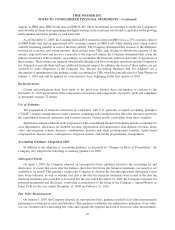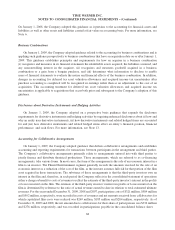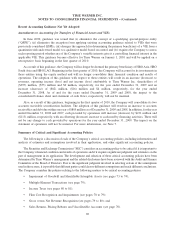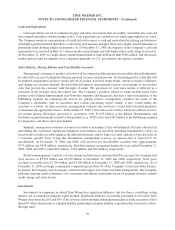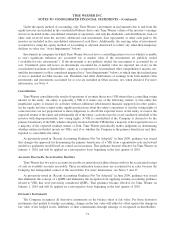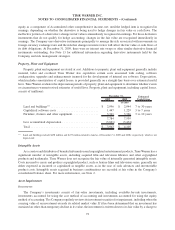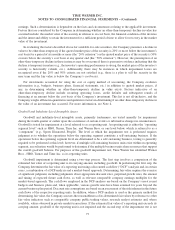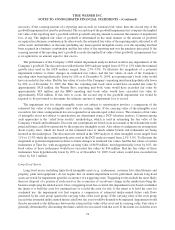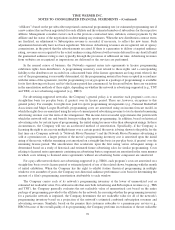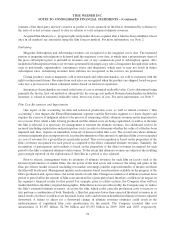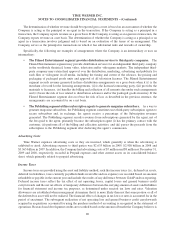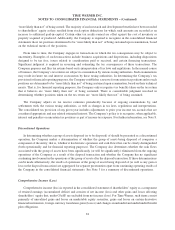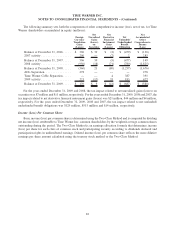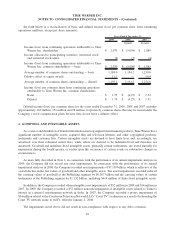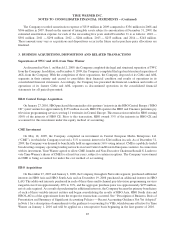Time Magazine 2009 Annual Report Download - page 87
Download and view the complete annual report
Please find page 87 of the 2009 Time Magazine annual report below. You can navigate through the pages in the report by either clicking on the pages listed below, or by using the keyword search tool below to find specific information within the annual report.for sale and certain other criteria are met (e.g., the asset can be disposed of currently, appropriate levels of authority
have approved the sale, and there is an active program to locate a buyer), the impairment test involves comparing the
asset’s carrying value to its estimated fair value. To the extent the carrying value is greater than the asset’s estimated
fair value, an impairment loss is recognized for the difference. Significant judgments in this area involve
determining whether a triggering event has occurred, determining the future cash flows for the assets involved
and selecting the appropriate discount rate to be applied in determining estimated fair value. For more information,
see Note 2.
Accounting for Pension Plans
Time Warner and certain of its subsidiaries have both funded and unfunded defined benefit pension plans, the
substantial majority of which are noncontributory, covering a majority of domestic employees and, to a lesser
extent, have various defined benefit plans, primarily noncontributory, covering international employees. Pension
benefits are based on formulas that reflect the employees’ years of service and compensation during their
employment period. The pension expense recognized by the Company is determined using certain
assumptions, including the expected long-term rate of return on plan assets, the interest factor implied by the
discount rate and the rate of compensation increases. The determination of these assumptions is discussed in more
detail in Note 11.
Equity-Based Compensation
The Company measures the cost of employee services received in exchange for an award of equity instruments
based on the grant-date fair value of the award. That cost is recognized in the consolidated statement of operations,
net of the cost of the awards expected to be forfeited over the period during which an employee is required to
provide service in exchange for the award. Also, excess tax benefits realized from the exercise of stock options are
reported as a financing cash inflow rather than as a reduction of taxes paid in cash flow from operations.
The grant-date fair value of a stock option is estimated using the Black-Scholes option-pricing model. Because
the Black-Scholes option-pricing model requires the use of subjective assumptions, changes in these assumptions
can materially affect the fair value of the options. The Company determines the volatility assumption for these stock
options using implied volatilities data from its traded options. The expected term, which represents the period of
time that options granted are expected to be outstanding, is estimated based on the historical exercise experience of
Time Warner employees. Groups of employees that have similar historical exercise behavior are considered
separately for valuation purposes. The risk-free rate assumed in valuing the options is based on the U.S. Treasury
yield curve in effect at the time of grant for the expected term of the option. The Company determines the expected
dividend yield percentage by dividing the expected annual dividend by the market price of Time Warner common
stock at the date of grant.
For awards granted prior to January 1, 2006, the Company recognizes equity-based compensation expense for
awards with graded vesting by treating each vesting tranche as a separate award and recognizing compensation
expense ratably for each tranche. For equity awards granted subsequent to January 1, 2006, the Company treats such
awards as a single award and recognizes equity-based compensation expense on a straight-line basis (net of
estimated forfeitures) over the employee service period. Also, when recording compensation cost for equity awards,
the Company is required to estimate the number of equity awards granted that are expected to be forfeited. Equity-
based compensation expense is recorded in costs of revenues or selling, general and administrative expense
depending on the job function of the grantee. For more information, see Note 10.
Revenues and Costs
Networks
The Networks segment recognizes Subscription revenues as programming services are provided to cable
system operators, satellite distribution services, telephone companies and other distributors (collectively,
75
TIME WARNER INC.
NOTES TO CONSOLIDATED FINANCIAL STATEMENTS – (Continued)




